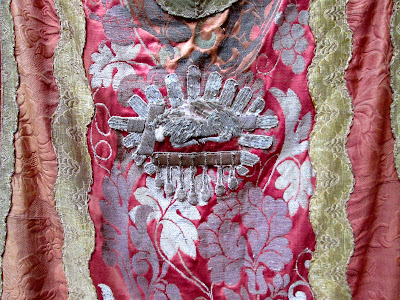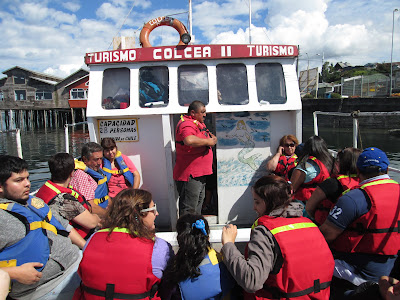Veggies, herbs, teas, and seaweed at the markets
I traveled all around the northern part of the island. First I was in Ancud, a quaint city in the north that is relaxed but somewhat touristy. In the regional museum, I learned that the city was flattened and flooded by the infamous Earthquake of 1960. They've done a great job of rebuilding, because you can barely tell now. The city has cafés, lots of vendors selling woolen and wooden artesanía, bakeries, and a cute central square.
Street art in Ancud
On my first day there, I went to a Penguin Colony at the Islotes de Puñihuil. From September through March, penguins from two different oceanic currents come to breed on these small islands. There are both Magellenic and Humboldt penguins - it's rare for them to be found together.
Penguin facts:
-They mate for life (but if the male dies first, the female finds another)
-New couples make new houses (nests), while old couples always return to the same one each year.
-They live 25-30 years.
-They can swim 80 meters below the water's surface, and eat underwater.
-They are so cute when they waddle down the rocks!
Near Puñihuil Beach
Laying seaweed out to dry - a gelatinous component of the algae is exported for use in cosmetics, food, etc.
Penguin domain
Then I visited several small fishing towns along the northeastern coast. Most towns have a wooden church, going along with the longstanding carpentry and architectural traditions of the island. Several of the Chilote churches are UNESCO World Heritage Sites. Most are very simple, with meticulous woodwork, and others are more ornate on the insides.
ANCUD - quiet northern city:
Church and museum in Ancud
Models of traditional Chilote Churches
Native wood used in carpentry
These are antique designs that priests on the island wore. I think that the pastoral part of the culture is represented beautifully here.
In the church courtyard
DALCAHUE - small coastal town:
Dalcahue's port
Dalcahue's wooden church, facing the water
Colorful gardens
The streets of Dalcahue
CURACO DE VELEZ - a tiny speck of a town on the island of Quinchao:
To my surprise, they have wi-fi in the town square!
Artesanía
ACHAO - Quinchao Island's largest town, with the oldest church:
Chiloé's oldest Church, built in 1740
At the end of the trip I went to Castro, Chiloé's large bustling city. It is the industrial, working man's town - with lots of traffic and hole-in-the-wall shops. It's the kind of place that has a veterinary office in between two butcher shops.
Castro's Easter-y church
The streets of Castro
Palafitos
Yes, I used a camera effect
Milcao - typical food of the central region. It is made of cooked potatoes, grated raw potatoes, flour, and pieces of meat, then fried.
Cazuela Chilote - a stew with potatoes, carrots, corn, and about 5 different types of seafood. Delicious!
The sunset as I left the island on the ferry. I even saw 3 dolphins jumping and flipping away into the distance - a sighting that I probably couldn't have gotten on a planned or paid tour.




















































No comments:
Post a Comment